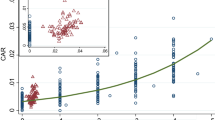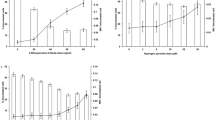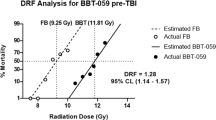Abstract
INCREASING quantities of plutonium-239 are processed in the nuclear power industry. The likely magnitude of the associated genetic risk is still uncertain but thought to be less than the risk of cancer induction1. Green et al.2 have recently shown, however, that plutonium reaching the testis after intravenous injection of 239Pu citrate into CBA mice concentrates in the interstitial tissue, outside the seminiferous tubules. They calculated that the average dose rate to spermatogonial stem cells, in which genetic damage can accumulate, was about 2–2.5 times that to the whole testis. In these circumstances, the genetically significant dose is higher than the average tissue dose, which is that normally used for protection purposes1. To obtain more direct evidence on genetic damage from gonadal plutonium, we are studying the induction of chromosome aberrations in germ cells of male mice after protracted exposure to α particles from 239Pu. The results of the first experiment, described here, suggest that α radiation has the expected high relative biological effectiveness (RBE)3 for induction of chromosome damage and that a distribution factor of the magnitude proposed may indeed be operating as well.
This is a preview of subscription content, access via your institution
Access options
Subscribe to this journal
Receive 51 print issues and online access
$199.00 per year
only $3.90 per issue
Buy this article
- Purchase on Springer Link
- Instant access to full article PDF
Prices may be subject to local taxes which are calculated during checkout
Similar content being viewed by others
References
Medical Research Council, The Toxicity of Plutonium (HMSO, London, 1975).
Green, D., Howells, G. R., Humphreys, E. R., and Vennart, J., Nature, 255, 77 (1975).
ICRP, Recommendations (ICRP publication 9, Pergamon, Oxford, 1966).
Evans, E. P., Breckon, G., and Ford, C. E., Cytogenetics, 3, 289–294 (1964).
Searle, A. G., and Beechey, C. V., Mutat. Res. 22, 63–72 (1974).
Bruce, W. R., Furrer, R., and Wyrobek, A. J., Mutat. Res., 23, 381–386 (1974).
Léonard, A., Mutat. Res., 11, 71–88 (1971).
Searle, A. G., and Beechey, C. V., Mutat. Res., 24, 171–186 (1974).
Leonard, A., and Deknudt, G., Radiat. Res., 40, 276–284 (1969).
Lyon, M. F., and Morris, T., Mutat. Res., 8, 191–198 (1969).
Searle, A. G., Evans, E. P., and West, B. J., Mutat. Res., 7, 235–240 (1969).
Russell, W. L., Genetics, 41, 658–659 (1956).
Oakberg, E. F., Nature, 180, 1137–1139 (1957).
Searle, A. G., Evans, E. P., Ford, C. E., and West, B. J., Mutat. Res., 6, 427–436 (1968).
ICRP, The RBE for High-LET Radiations with respect to Mutagenesis (ICRP publication 18, Pergamon, Oxford, 1972).
Lederer, C. M., Hollander, J. M., and Perlman, I., Table of Isotopes, sixth ed. (Wiley, New York, 1967).
Author information
Authors and Affiliations
Rights and permissions
About this article
Cite this article
BEECHEY, C., GREEN, D., HUMPHREYS, E. et al. Cytogenetic effects of plutonium-239 in male mice. Nature 256, 577–578 (1975). https://doi.org/10.1038/256577a0
Received:
Accepted:
Issue Date:
DOI: https://doi.org/10.1038/256577a0
This article is cited by
-
Genetic risks to man from exposure to long-lived radionuclides
Journal of Radioanalytical and Nuclear Chemistry Articles (1990)
-
The toxicity of 90Sr, 226Ra and 239Pu
Nature (1976)
Comments
By submitting a comment you agree to abide by our Terms and Community Guidelines. If you find something abusive or that does not comply with our terms or guidelines please flag it as inappropriate.



